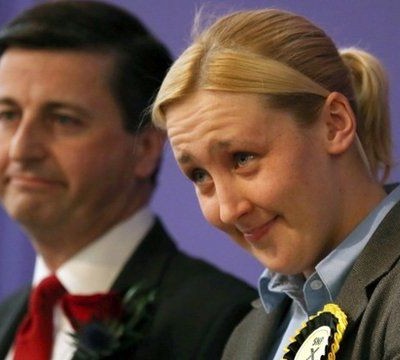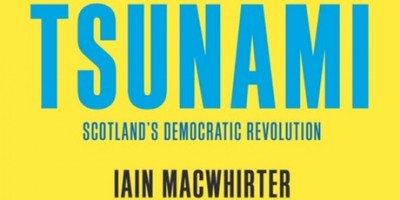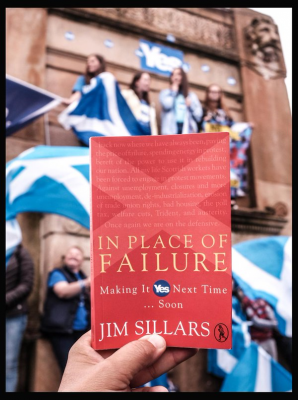Two very different books on Scotland’s post-indyref options are united by a glaring omission, says Paddy Bort
Support independent, non-corporate media.
Donate here!

Iain Macwhirter, Tsunami: Scotland’s Democratic Revolution (Freight Books) Jim Sillars, In Place of Failure: Making It Yes Next Time…Soon (Vagabond Voices)
Are we presently going though a democratic revolution – and, what’s more, a ‘peaceful and joyous one’? ‘The post-referendum political kaleidoscope continues to rearrange itself in novel and unpredictable ways,’ writes Iain Macwhirter. ‘We are some way from seeing the final picture, but there can be no doubt that we are living through the most exciting and transformative period in Scottish History.’ Bold claims. If the independence referendum was good for publishers, a politically engaged readership lapping up dozens of titles during the campaign, this phenomenon has continued after the vote, particularly as the fallout from the referendum result turned out in a rather unexpected way, culminating in the SNP landslide victory at the UK General Elections in May.
‘The referendum turns out to be more intriguing in its aftermath,’ Lindsay Paterson noted in Scottish Affairs, ‘than the rather familiar debates that led up to the vote.’ A first wave of analyses of the referendum campaigns, mostly in the guise of campaign diaries by politicians and journalists, are now being followed by books on the remarkable General Election result, and the question of when, rather than if, a second referendum on Scottish independence might be held, what might trigger it, and how a second round of campaigning might shape up.
Two of the usual suspects, the journalist Iain Macwhirter – an astute observer of, and commentator on, Scottish politics since the 1979 referendum – and the former Deputy Leader of the SNP, Jim Sillars – lured back into the political arena by the independence referendum – have added, respectively, Tsunami: Scotland’s Democratic Revolution and In Place of Failure: Making It Yes Next Time…Soon to their previous indyref output. Both continue where they left off with their most recent publications, Macwhirter as a chronicler who became a firm supporter of Yes, and Sillars as a Yes activist.
In Road to Referendum and Disunited Kingdom, Macwhirter tracked the campaign and interpreted the outcome of the Referendum. In Tsunami, he now develops the story further to explain how the losers of the Referendum have turned into the tsunami-like winners of the General Election. He sees this ‘revolution’ rooted in the campaign, the civic engagement that led not just to a record voter turnout in September, but to an electorate with ‘hundreds of thousands of Scottish voters who refuse to give up on the possibility of change.’ After the referendum defeat, they did not ‘get back in their box.’ They continued with their ‘festival of democracy’, rather than seeking ‘consolation in negativity and cynicism.’ David Cameron undoubtedly helped by rushing to introduce EVEL in his post-Referendum statement. The main beneficiary of all that was the SNP which, now led by ‘Saint Nicola’, hoovered up among the Yes supporters, gaining nearly 100,000 new party members – and (by lifting the rule that new members had to wait a year before they could stand in an election) a host of new candidates.
On the other side, Labour plunged itself into an existential crisis. Already badly bruised by being associated with the Tories in Better Together, the resignation of Johann Lamont exacerbated the situation further. Her parting shot was that ‘the Labour Party must recognise that the Scottish party has to be autonomous and not just a branch office of a party based in London.’ She was replaced by Jim Murphy – ‘the wrong politician in the wrong place at the wrong time.’ But Macwhirter, no friend of Murphy’s, also conceded that ‘Nelson Mandela himself could not have turned around Labour’s fortunes in these few short months.’
Despite the landslide victory in Scotland, the SNP does not hold the balance of power at Westminster. The way David Cameron ruthlessly exploited Labour’s Scottish difficulty by suggesting ‘that a Labour government would not be democratically legitimate if it relied on SNP votes in the Commons’ was, not just in Macwhirter’s view, ‘contrary to parliamentary democracy as well as objectionable to Scottish voters.’ But it was effective. Cameron’s SNP scare may well have been decisive in securing the Tories their unexpected majority, but it also, Macwhirter contends, drove ‘a stake through the heart of the Union.’ It also helped the SNP no end that the Daily Mail called Nicola Sturgeon, after her appearance in the Leaders’ TV Debate, ‘the most dangerous woman in Britain.’
There’s a lot of to-ing and fro-ing about whether the Vow has been fulfilled. The Vow itself was vague enough for that debate to never end. But it has become abundantly clear, and Gordon Brown has vented his frustration anent that fact, that any aspiration towards a fundamental debate about he British constitution – including forms of federalism – is not on the cards. Macwhirter has little hope that there might yet be ‘a flash of constitutional imagination.’ After the Tory victory of May, ‘there seems very little prospect of Westminster reforming itself in time.’
While Macwhirter concedes that proper engagement with ‘legitimate concerns’ of the No side (currency, Europe, pensions) is necessary to swing the electorate behind Yes, for Sillars the main fault of the Yes campaign was that it did not expose those ‘Project Fear’ lies sufficiently and efficiently to save the Scots from making the wrong decision. His take on the ‘failure’ of last year’s referendum puts the blame firmly on ‘Project Fear’. In his view, No voters were lied to, deceived and, ultimately duped by a combination scaremongering and misinformation from the Westminster parties, big business and the ‘mainstream media’. Next time round, he argues, the Yes campaign needs to be better prepared. Now we know what the establishment will throw at us, stock up on the counter arguments.
He also offers criticism of the structure and design of the Yes campaign – it was too dependent on the SNP and its’ money, and on SNP policy as laid out in the White Paper – particularly the currency union and the 10% reduction in corporation tax. In In Place of Fear II, he had developed a socialist manifesto for an independent Scotland, as an alternative to the White Paper. But in the coverage of the national campaign by the media, ‘the role of the SNP and its leadership eclipsed the rest, and that proved a weakness.’
But while Sillars reminds us of the breadth of the independence movement, he falls somewhat short on fully engaging with the grassroots campaigns. He is also unrepentant about his ‘day of reckoning’ comments just days before the referendum – which, at the time, were seen as less than helpful to the Yes cause. That Yes repudiated that statement so defensively was, in Sillars’s book, ‘an indication of how unprepared the Yes movement was to tackle companies that were then illegitimately in cahoots with a Tory prime minister bent on instilling fear in people.’
Macwhirter’s book is subtitled ‘Scotland’s Democratic Revolution’. Maybe a wee question-mark might have been appropriate? Sure, the public engagement level towards the end of the referendum campaign and the voter turnout in September were unprecedented, and the total turning of the tables in May had a revolutionary air about it. But the Smith Commission, despite 12,000 submissions from the public, was ‘a four party stitch-up’. Public engagement during the General Election campaign seemed less pronounced than during Indyref1. An academic study from Aberdeen University linked that primarily with the fact that 16-18 year-olds were excluded from the vote in May. We’ll discover in May next year whether the Scottish elections, in which the franchise is the same as last September, will see comparable levels of voter engagement.
Does all that add up to a revolution yet? Or has one establishment (Labour) had to give way to a new establishment (the SNP)? ‘If we want things to stay as they are, things will have to change,’ runs the most famous line in The Leopard (1958) – the great Sicilian novel by Guiseppe Tomasi di Lampedusa. As James Mitchell, Lynn Bennie and Rob Johns have shown, the SNP rapidly transformed itself into a mainstream party when it transitioned into power in 2007. A Scottish Podemos it is clearly not, as Macwhirter notes. Is the SNP, rather, Scotland’s New Labour? In more than one sense? Not just replacing Labour as the party of government, but also increasingly showing characteristics of New Labour? The SNP has, as their party conference in Aberdeen showed, become a slick, top-down machine. Helen Lewis of the New Statesman saw the Aberdeen conference haunted ‘by the spectre of New Labour’. Apart from the debates about fracking and land reform, she noted ‘total message discipline and little dissent from the floor.’
Sillars’ hope that the new intake would flex its muscle and challenge Nicola Sturgeon’s cautious approach towards a second referendum remained largely unfulfilled. Macwhirter explains Sturgeon’s strategy – first, a mandate for herself and her party to govern another five years after the Holyrood elections of May 2016, using the powers of Holyrood to build more trust in the SNP as the party of government and win over the ‘sceptical middle classes’; then, there needs to be ‘material change’. That could be a differential vote on Brexit, further austerity and the decision of renew Trident. And, thirdly, there would have to be a clear and consistent lead in the polls over a sustained period of time to indicate that a sufficient number of erstwhile No voters have changed their mind in order to make victory likely. Nicola Sturgeon does not just want another referendum, she wants to win that referendum. And for that reason, Macwhirter argues, it will be some years before another referendum happens.
Sillars is in a rush. He fears that valuable momentum could get lost. His view is that the SNP risks making a ‘strategic error’ if it puts off seeking a mandate for a second independence referendum at next year’s Holyrood elections. The book reflects his analysis given in a letter to the National this summer: ‘To my mind the priority for the independence movement is independence – not to extract one or two morsels to put into the Scotland bill. It is to gain independence as soon as possible, and the only way to do that is by campaigning for it. And at the moment there is no independence campaign being conducted by the SNP.’ While Macwhirter applauds Nicola Sturgeon’s ‘utilitarian nationalism’, Sillars clearly espouses the other end of the spectrum – ‘existential nationalism’. More recently, he has called on independence supporters to regroup and prepare for a fresh referendum. ‘The SNP, the Greens, the Scottish Socialist Party and all those who support independence need to convene a conference early next year to come together and plan out a winning strategy for the next time.’ The operative word in his book’s subtitle is ‘soon’.
While musing on the ‘Pasokification’ of Scottish Labour, Macwhirter also assesses the risks of Sturgeon’s strategy. Governments do not necessarily become more popular the longer they are in office. He notes Kezia Dugdale’s ‘tenacious…challenges to the First Minister’ on ‘breaking her own party’s pledges on waiting times in Accident and Emergency,’ the ‘withering scrutiny’ of the ‘“reckless” policy of full fiscal autonomy…, especially after the collapse of oil prices in December 2014’. He adds the challenges over Police Scotland. And that other ‘revolution’ – of the Corbynite kind, south of the border, which begins to challenge the SNP from the left. While Tsunami is full of the demise of Scottish Labour, Macwhirter has noted some comeback after the party’s Perth conference. ‘The Scottish Labour Party has rediscovered its soul,’ he wrote, commenting on the vote against Trident. And there are the Greens and other groups, like RISE, vying for votes on the Left.
Finally, a blind spot – in both writers’ accounts. Not a word in either Sillars or Macwhirter on local democracy, or the lack thereof, in Scotland. Neal Ascherson’s ‘on the bus’ experience was that the lack of local democracy – local decision-making, local accountability, communities not being empowered to run their own affairs – was the first and most pressing issue raised at every stop of the tour. Despite COSLA’s intervention (Effective Democracy: Reconnecting with Communities, 2014) just before the referendum, there has since been a deafening silence on fundamental local government reform. ‘It’s hard to see how people deemed incapable of running their towns and villages – uniquely in Europe – will confidently vote to run their own country,’ commented Lesley Riddoch in her preface to the Reid Foundation’s The Silent Crisis (2012). Without addressing that democratic deficit at the heart of Scotland’s polity, talk of a ‘democratic revolution’ has a somewhat hollow ring about it.











